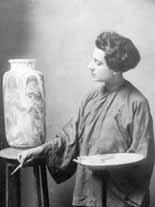
Louise Janin was a fascinating idiosyncratic symbolist painter who evolved a special marbling technique to capture the spiritual energy of the Cosmos.
Born in America and attending the California School of Art in 1911, Janin then travelled extensively through Asia becoming inspired by the Eastern teachings such as Buddhism, Taoism and Hinduism, and her paintings became imbued with Spiritual symbolism.
After briefly returning to America in 1920 where she found herself regarded as an “Orientalist” painter, Janin was drawn to the avant-garde atmosphere of Paris where artists such as Kandinsky were exploring the realm of spirituality through abstraction. She formed important friendships with Frantisek Kupka and Henri Valensi who were at the forefront of the movement, and with whom she would later join the “Musicaliste” group in 1932. In 1924 the prestigious Galere Bernheim-Jeune held an exhibition of her work, and the Luxembourg Museum acquired one of paintings, as well as the Theosophical Society of France.
With the outbreak of war Janin went to Corsica, but was subsequently interned in a camp in Italy. Luckily surviving the ordeal, she returned to her art which became increasingly abstracted whilst still concerned with a metaphysical esoteric purpose. Exhibiting at the new avant-garde Salon des Réalités Nouvelles in 1950, she then developed her special “marbling” technique, to create “Cosmogrammes”, capturing instances comic energy in beautifully meditative and poetic patterns.
Whilst Janin exhibited regularly at the salons her predominant spiritualism and disinclination to be drawn into artistic academicism left her somewhat outside the narrow Modernist art historical narrative. But with the benefit of perspective the significance of her work is now becoming increasingly appreciated. Her work was recently included in the Centre Pompidou exhibition “Elles font l’abstraction, une autre histoire de l'abstraction au 20e siècle” in 2021.